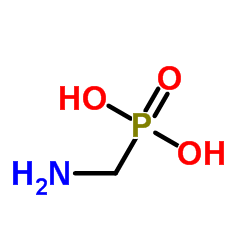Aminomethylphosphonic acid

Aminomethylphosphonic acid structure
|
Common Name | Aminomethylphosphonic acid | ||
|---|---|---|---|---|
| CAS Number | 1066-51-9 | Molecular Weight | 111.037 | |
| Density | 1.6±0.1 g/cm3 | Boiling Point | 358.0±44.0 °C at 760 mmHg | |
| Molecular Formula | CH6NO3P | Melting Point | 300 °C | |
| MSDS | Chinese USA | Flash Point | 170.3±28.4 °C | |
|
Developmental tightening of cerebellar cortical synaptic influx-release coupling.
J. Neurosci. 35(5) , 1858-71, (2015) Tight coupling between Ca(2+) channels and the sensor for vesicular transmitter release at the presynaptic active zone (AZ) is crucial for high-fidelity synaptic transmission. It has been hypothesized that a switch from a loosely coupled to a tightly coupled ... |
|
|
Glutamatergic receptor dysfunction in spinal cord contributes to the exaggerated exercise pressor reflex in heart failure.
Am. J. Physiol. Heart Circ. Physiol. 308(5) , H447-55, (2015) Excitatory amino acids (e.g., glutamate) released by contraction-activated skeletal muscle afferents into the dorsal horn of the spinal cord initiate the central component of the exercise pressor reflex (EPR) in physiological conditions. However, the role of ... |
|
|
Altering in vivo macrophage responses with modified polymer properties.
Biomaterials 56 , 187-97, (2015) Macrophage reprogramming has long been the focus of research in disease therapeutics and biomaterial implantation. With different chemical and physical properties of materials playing a role in macrophage polarization, it is important to investigate and categ... |
|
|
Identification and characterization of GABA(A) receptor autoantibodies in autoimmune encephalitis.
J. Neurosci. 34(24) , 8151-63, (2014) Autoimmune forms of encephalitis have been associated with autoantibodies against synaptic cell surface antigens such as NMDA- and AMPA-type glutamate receptors, GABA(B) receptor, and LGI1. However, it remains unclear how many synaptic autoantigens are yet to... |
|
|
Regulation of AMPA receptor phosphorylation by the neuropeptide PACAP38.
Proc. Natl. Acad. Sci. U. S. A. 112 , 6712-7, (2015) Dynamic changes in synaptic strength are thought to be critical for higher brain function such as learning and memory. Alterations in synaptic strength can result from modulation of AMPA receptor (AMPAR) function and trafficking to synaptic sites. The phospho... |
|
|
Radixin regulates synaptic GABAA receptor density and is essential for reversal learning and short-term memory.
Nat. Commun. 6 , 6872, (2015) Neurotransmitter receptor density is a major variable in regulating synaptic strength. Receptors rapidly exchange between synapses and intracellular storage pools through endocytic recycling. In addition, lateral diffusion and confinement exchanges surface me... |
|
|
Store-operated calcium entry compensates fast ER calcium loss in resting hippocampal neurons.
Cell Calcium 58 , 147-59, (2015) The endoplasmic reticulum (ER) acts as a dynamic calcium store and is involved in the generation of specific patterns of calcium signals in neurons. Calcium is mobilized from the ER store by multiple signaling cascades, and neuronal activity is known to regul... |
|
|
Efficient fluorescence resonance energy transfer between oppositely charged CdTe quantum dots and gold nanoparticles for turn-on fluorescence detection of glyphosate.
Talanta 125 , 385-92, (2014) We designed a turn-on fluorescence assay for glyphosate based on the fluorescence resonance energy transfer (FRET) between negatively charged CdTe quantum dots capped with thioglycolic acid (TGA-CdTe-QDs) and positively charged gold nanoparticles stabilized w... |
|
|
Pathophysiological mechanisms underlying increased anxiety after soman exposure: reduced GABAergic inhibition in the basolateral amygdala.
Neurotoxicology 44 , 335-43, (2014) The recent sarin attack in Syria killed 1429 people, including 426 children, and left countless more to deal with the health consequences of the exposure. Prior to the Syrian chemical assault, nerve agent attacks in Japan left many victims suffering from neur... |
|
|
Enhancing Protein Expression in HEK-293 Cells by Lowering Culture Temperature.
PLoS ONE 10(4) , e0123562, (2015) Animal cells and cell lines, such as HEK-293 cells, are commonly cultured at 37°C. These cells are often used to express recombinant proteins. Having a higher expression level or a higher protein yield is generally desirable. As we demonstrate in this study, ... |